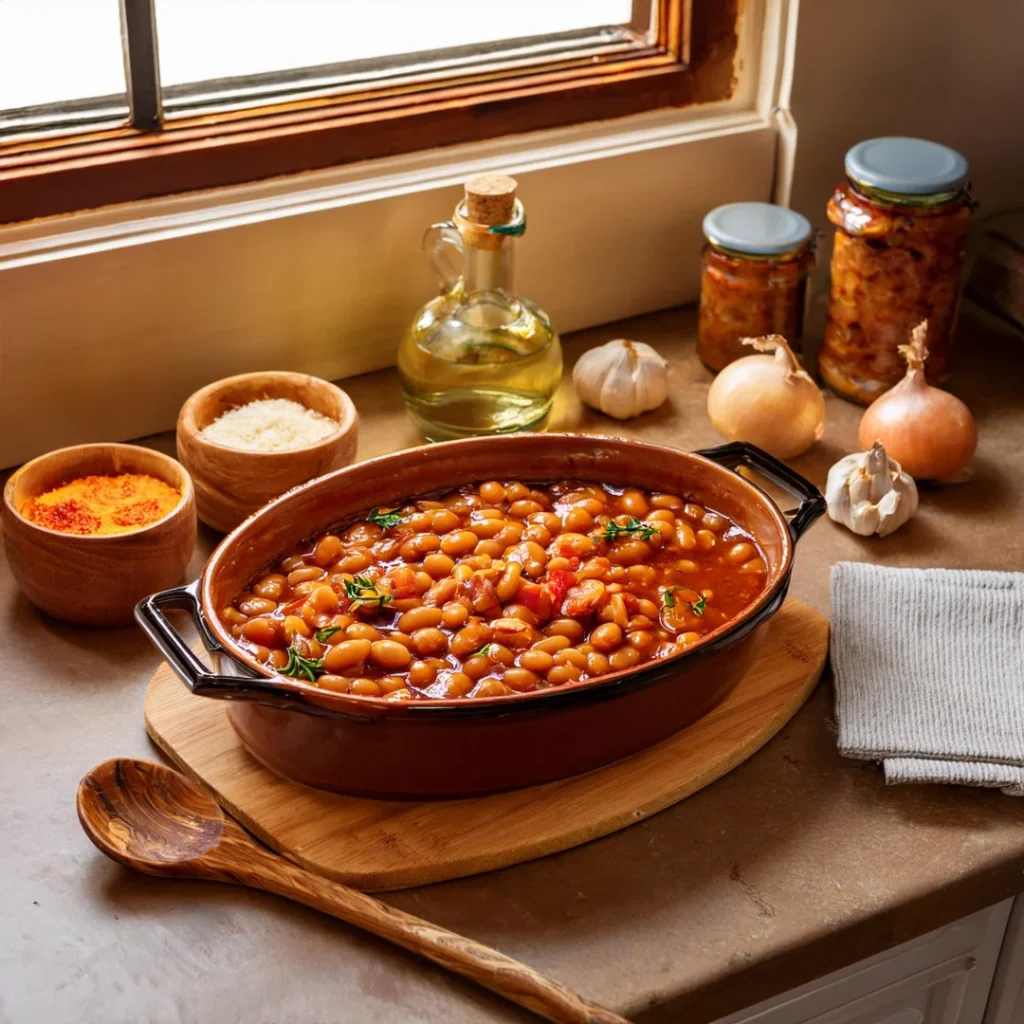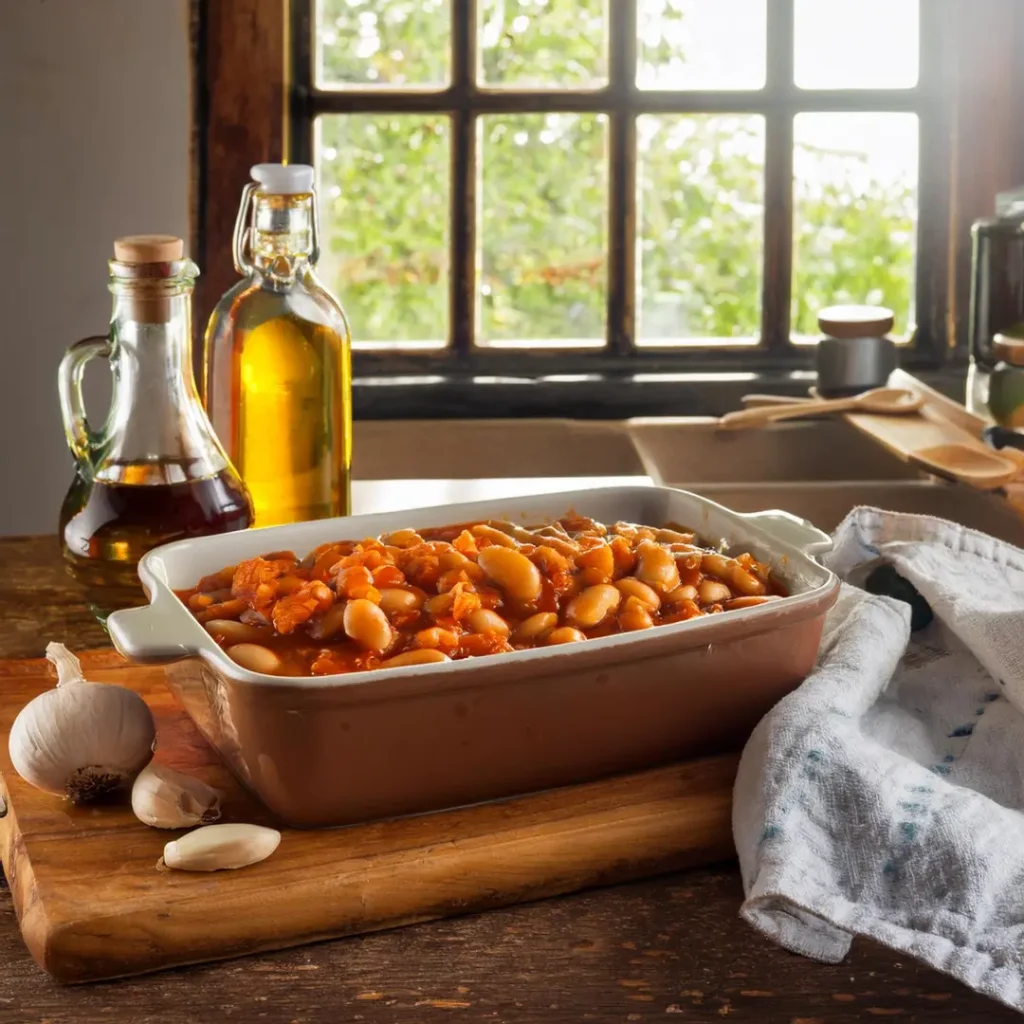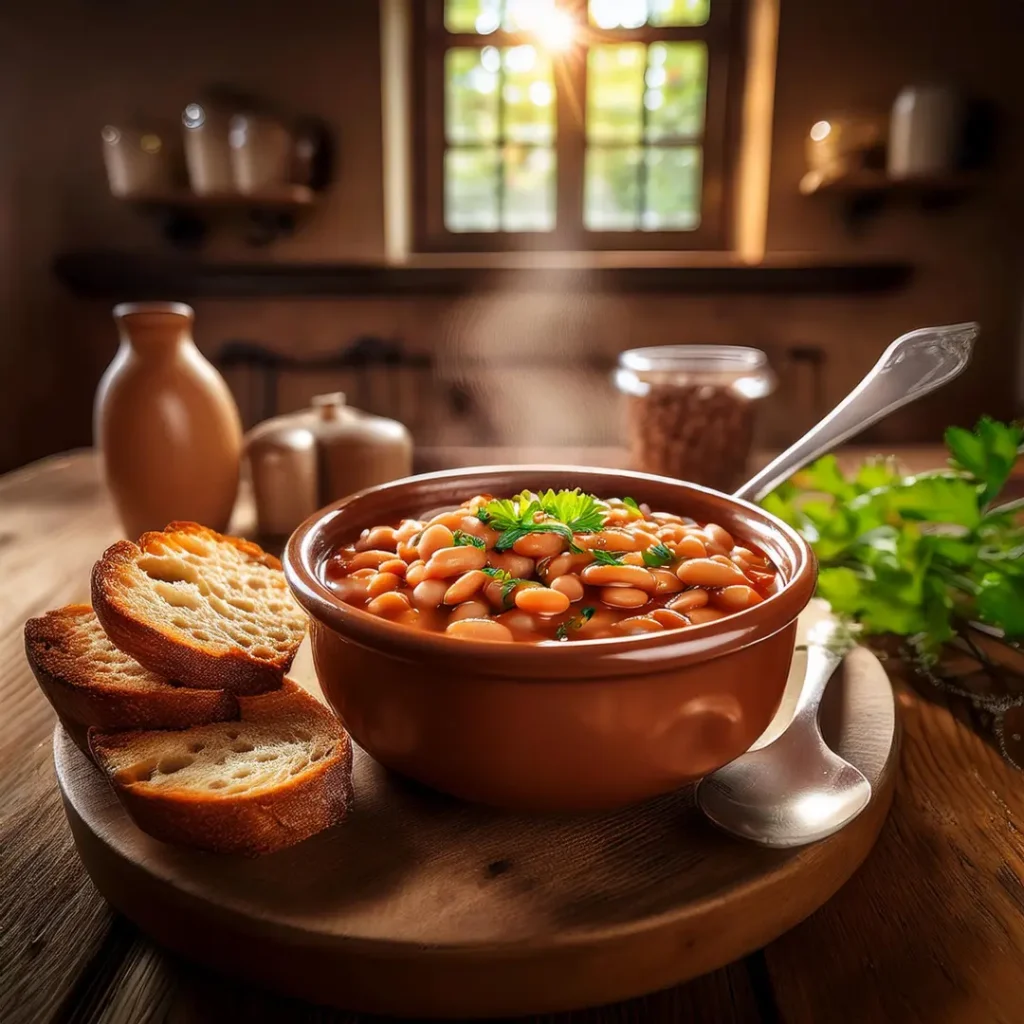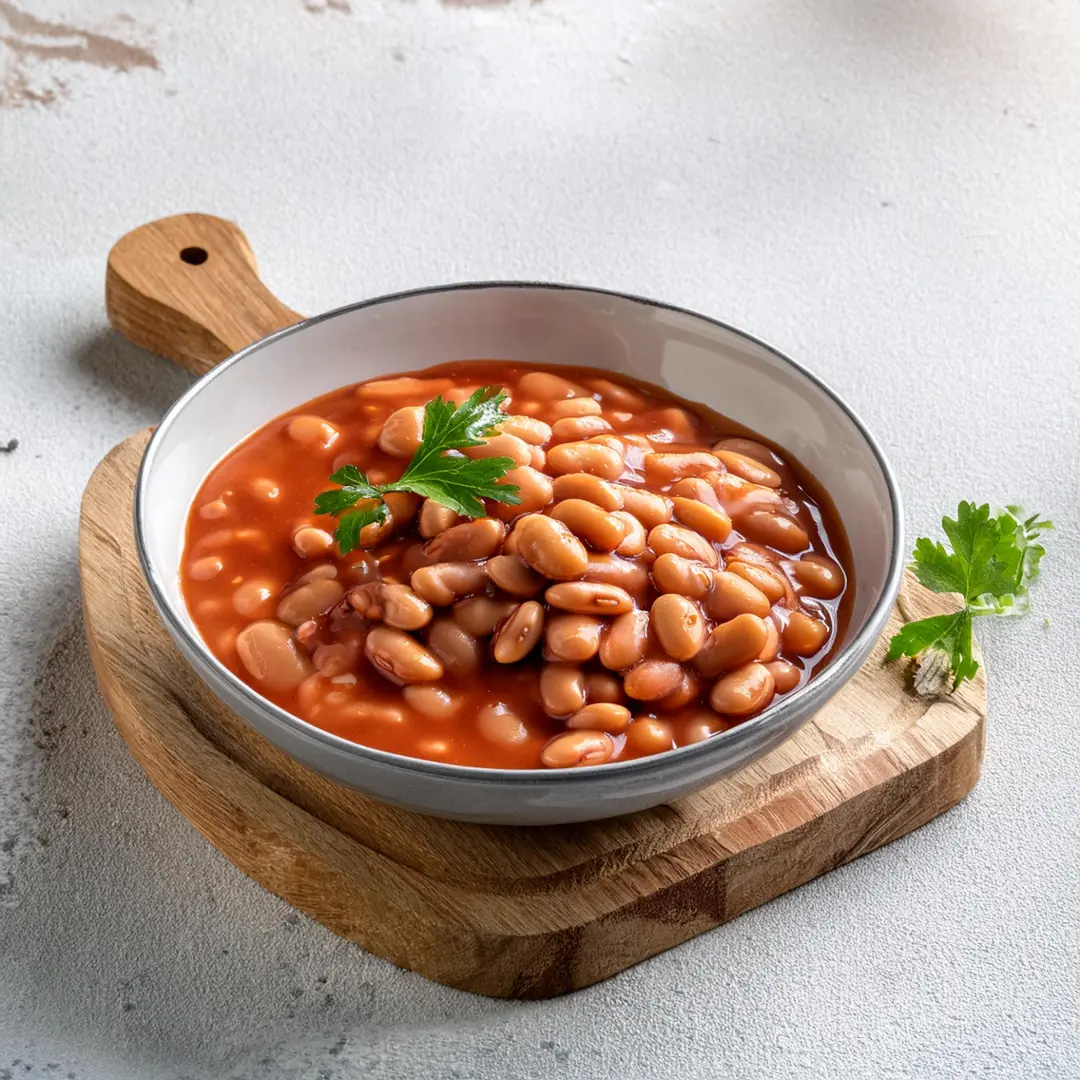Introduction
There’s something undeniably comforting about a warm, flavorful pot of baked beans. Whether served as a hearty side dish at a summer barbecue, a potluck favorite, or even as a standalone meal on a chilly evening, baked beans have earned their place as a classic comfort food in many households. But what makes a baked beans recipe truly “ultimate”? It’s the perfect balance of sweet, smoky, and tangy flavors paired with tender, slow-cooked beans that practically melt in your mouth.
This recipe isn’t just any baked beans recipe—it’s your go-to guide to creating a rich, flavorful dish that’s easy to prepare and guaranteed to impress. From carefully selected ingredients like molasses and brown sugar to cooking techniques that maximize flavor, every step of this recipe has been designed with simplicity and deliciousness in mind.
Whether you’re a fan of traditional baked beans, prefer a vegetarian twist, or want to spice things up with bold flavors, this guide has got you covered. With just a few pantry staples and some simple steps, you can whip up a batch of ultimate baked beans right in your kitchen. Get ready to transform this humble dish into the star of your next meal!
Introduction to the Ultimate Baked Beans Recipe
1. Why baked beans are a comfort food staple.
The magic of a perfect baked beans recipe lies in its carefully selected ingredients. At the heart of this dish are the beans, traditionally navy beans, but pinto or great northern beans work wonderfully as well, providing a tender texture that soaks up all the flavorful sauce.
Key to the sauce’s signature richness is molasses, which imparts a deep, slightly smoky sweetness. This is balanced by brown sugar, adding caramelized notes and enhancing the dish’s comforting sweetness. Ketchup and mustard bring tangy, savory elements that harmonize beautifully, creating a sauce that’s both vibrant and complex.
To elevate the flavor, onions and garlic provide a savory base, adding depth and aroma to the dish. Optional ingredients like apple cider vinegar, Worcestershire sauce, or even a splash of BBQ sauce can add a personalized touch, making the sauce uniquely yours.
These ingredients, when combined thoughtfully, create a dish that’s rich, hearty, and irresistibly flavorful—a true crowd-pleaser!
2. Optional ingredients for flavor variations: BBQ sauce, Worcestershire sauce, apple cider vinegar.
Optional ingredients can take your baked beans recipe to the next level by adding unique layers of flavor and complexity. BBQ sauce is a popular addition that enhances the dish with a smoky, tangy sweetness. Depending on the type of BBQ sauce you choose—whether it’s honey-based, spicy, or bold—you can customize the flavor profile to match your preferences or complement the rest of your meal.
Worcestershire sauce is another fantastic optional ingredient, bringing a savory, umami-packed depth to the dish. Just a small splash can make a big difference, rounding out the flavors of the sauce and enhancing its richness.
For a touch of acidity that cuts through the sweetness and balances the dish, consider adding apple cider vinegar. Its mild tanginess brightens the overall flavor, giving your baked beans a delightful contrast and preventing the sauce from becoming overly sweet.
These optional ingredients allow you to experiment and create a signature version of baked beans that’s uniquely yours!
3. Substitutions: Halal options for bacon or vegetarian alternatives.
If you want to make your baked beans recipe suitable for halal diets or vegetarian preferences, there are plenty of flavorful substitutions to replace traditional bacon. For halal options, consider using beef bacon or turkey bacon. These alternatives deliver a smoky, savory taste that mirrors the richness of traditional pork bacon, ensuring your baked beans still have that classic depth of flavor.
For a vegetarian twist, you can skip the meat entirely and replace the smoky flavor with ingredients like smoked paprika or liquid smoke. These seasonings replicate the essence of bacon while keeping the dish plant-based. You might also try tempeh bacon or coconut bacon, which are popular vegetarian options that add both texture and a smoky profile.
By using these substitutions, you can cater to a variety of dietary needs without compromising the rich, hearty flavor that makes baked beans such a beloved dish!
4. Importance of using quality ingredients for the best flavor.
When it comes to creating the ultimate baked beans, the quality of your ingredients can make or break the dish. Starting with the beans, whether you use dried beans or canned, choosing fresh, high-quality beans ensures a tender, creamy texture that perfectly absorbs the flavors of the sauce.
Sweeteners like molasses and brown sugar play a key role in the recipe’s flavor profile. Opt for pure, unsulfured molasses for a deep, rich sweetness that’s free from artificial aftertastes. Similarly, using high-quality brown sugar brings a natural caramelized note that elevates the dish’s warmth.
For tangy ingredients such as ketchup, mustard, or apple cider vinegar, go for natural or organic options without added preservatives or excessive sugar to keep the flavors balanced. If you’re including optional ingredients like BBQ sauce or Worcestershire sauce, choosing premium brands can significantly enhance the smoky and umami elements.
Even small touches, like using fresh onions and garlic instead of powdered substitutes, contribute to a more robust and aromatic sauce. By prioritizing quality, you’ll create baked beans that are irresistibly flavorful, leaving everyone asking for seconds!
Step-by-Step Guide to Making Baked Beans at Home

1. Prepping the beans: soaking or using canned beans.
The foundation of any great baked beans recipe lies in properly preparing the beans. You have two main options: soaking dried beans or using canned beans, each with its own benefits.
If you’re starting with dried beans, soaking them is an essential step. Begin by rinsing the beans thoroughly to remove any dirt or debris. Soak them in water for 8–12 hours, preferably overnight. This not only softens the beans but also reduces cooking time and improves digestibility by breaking down complex sugars that can cause bloating. For a quicker alternative, try a quick-soak method: boil the beans for 2 minutes, then let them sit in hot water for an hour. After soaking, drain and rinse them before cooking.
Using canned beans is a convenient option, especially when you’re short on time. They’re pre-cooked and ready to use, saving you hours of preparation. However, it’s important to drain and rinse them thoroughly to remove excess sodium and improve their flavor.
Both methods yield delicious results, but soaking dried beans allows you to control the texture and flavor more precisely. Choose the approach that best suits your schedule, and you’ll have perfectly prepped beans ready for your baked beans masterpiece!
2. Creating the sauce: achieving the perfect balance of sweetness and smokiness.
The sauce is the soul of any baked beans recipe, and achieving the perfect harmony of sweetness and smokiness is what transforms this dish from ordinary to extraordinary. The key lies in balancing the right combination of ingredients.
For sweetness, molasses is the star ingredient, offering a deep, earthy sweetness with a hint of bitterness that adds depth to the sauce. Complement this with brown sugar, which provides a caramelized richness, and ketchup, which brings a touch of tanginess along with its subtle sweetness. For added layers of flavor, a drizzle of honey or a splash of maple syrup can elevate the sweetness while maintaining a natural, complex profile.
To achieve smokiness, you can’t go wrong with smoked paprika or a dash of liquid smoke. These ingredients replicate the bold, smoky flavor traditionally imparted by bacon. If you’re using BBQ sauce, choose one with a smoky base to further enhance this element.
Tangy ingredients like apple cider vinegar and mustard cut through the richness, balancing the sweetness and giving the sauce a vibrant edge. Don’t forget the aromatics—onions and garlic sautéed until fragrant create a savory base that ties all the flavors together.
3. Cooking techniques: baking in the oven, using a slow cooker, or simmering on the stovetop.
The cooking method you choose for your baked beans plays a significant role in determining the dish’s texture, flavor, and overall appeal. Each method has its own benefits, allowing you to tailor the process to your preferences and schedule.
- Baking in the Oven
The oven is the traditional method for making baked beans and delivers rich, caramelized flavors. After preparing the beans and sauce, transfer everything to a casserole dish or Dutch oven, cover it with a lid or foil, and bake at a low temperature (around 325–350°F) for 2–3 hours. This slow cooking allows the beans to absorb the flavors of the sauce while thickening naturally. For a caramelized finish, uncover the dish during the last 30 minutes of baking.
- Using a Slow Cooker
For a hands-off approach, the slow cooker is an excellent option. Combine the beans and sauce in the cooker and set it to low for 6–8 hours or high for 3–4 hours. This method ensures the beans remain tender and the sauce achieves a deep, rich flavor with minimal effort. It’s perfect for busy days when you want to “set it and forget it.”
- Simmering on the Stovetop
If you’re short on time or don’t want to heat up your oven, simmering the beans on the stovetop is a quick alternative. Cook the beans and sauce in a large pot over low heat, stirring occasionally to prevent sticking. This method allows you to monitor the texture and flavor closely, although it may require more attention to avoid overcooking or burning.
Each technique has its own charm, and you can choose the one that best fits your schedule and desired results. No matter the method, the goal is the same: tender beans coated in a flavorful, perfectly balanced sauce!
4. Tips for thickening or adjusting the sauce to your taste.
The sauce is the heart of baked beans, and achieving the ideal consistency and flavor is key to making the dish irresistible. Here are some tried-and-true tips to thicken or adjust the sauce to perfectly suit your taste.
- Thickening the Sauce
- Simmer Slowly: One of the simplest ways to thicken your sauce is to let it simmer uncovered on low heat. This allows excess liquid to evaporate gradually, concentrating the flavors and giving the sauce a rich, velvety texture.
- Cornstarch Slurry: Mix a teaspoon of cornstarch with a tablespoon of cold water, then stir it into the simmering sauce. This will thicken the sauce quickly without altering the flavor.
- Mashed Beans: For a natural thickener, mash a small portion of the cooked beans and stir them back into the sauce. The starches in the beans will help thicken the mixture while keeping it hearty and wholesome.
- Reduce Liquid: If the sauce seems too thin, reduce the quantity of water or stock added during preparation. Start with less liquid, then adjust as needed.
- Adjusting the Flavor
- Add Sweetness: If the sauce feels too tangy or smoky, balance it with a little extra brown sugar, molasses, or a drizzle of maple syrup.
- Boost Smokiness: For a deeper smoky flavor, add a few drops of liquid smoke, more smoked paprika, or a splash of smoky BBQ sauce.
- Increase Tanginess: If the sauce is too sweet, brighten it with a splash of apple cider vinegar or a dollop of mustard.
- Enhance Savory Notes: Stir in a bit of Worcestershire sauce, soy sauce, or even a pinch of salt to enhance the umami flavors.
By combining these techniques, you can customize the sauce to your preferred taste and texture, ensuring every bite of your baked beans is perfectly balanced and delicious!
Tips and Tricks for Perfect Baked Beans Every Time

1. How to adjust sweetness, smokiness, or tanginess to suit your preferences.
The versatility of homemade baked beans allows you to adjust their flavor profile to suit your taste, whether you prefer them sweeter, smokier, or tangier. Here’s how to tailor your recipe to perfection:
Adjusting Sweetness: Enhance sweetness by adding more brown sugar, molasses, honey, or maple syrup. These natural sweeteners add depth without becoming overpowering. For a subtle fruity touch, stir in a splash of apple or pineapple juice. If the dish becomes too sweet, balance it with tangy ingredients like vinegar or mustard.
Boosting Smokiness: Amplify smoky flavors with smoked paprika, liquid smoke, or smoky BBQ sauce. Crisping bacon or turkey bacon before adding it to the dish can also enhance smokiness. For a natural touch, cook the beans in a cast iron pot or add smoked meat (if dietary preferences allow).
Increasing Tanginess: Brighten the dish by incorporating apple cider vinegar, lemon juice, or mustard. For added complexity, use tamarind paste or pomegranate molasses to introduce a fruity tang.
Finding the Perfect Balance: Taste as you go, making incremental adjustments. Balance sweetness with tanginess or smokiness for a well-rounded flavor.
By fine-tuning these elements, you’ll create baked beans that are perfectly customized to your preferences, ensuring every bite is a personal delight!
2. Storing and reheating leftovers: keeping them fresh and flavorful.
save as leftovers. Proper storage and reheating techniques are key to preserving their freshness and enhancing their flavors.
- Storing Leftovers
- Cool Completely: Before storing, allow the baked beans to cool to room temperature. This helps prevent condensation, which can make the sauce watery.
- Use Airtight Containers: Transfer the beans to an airtight container to maintain their flavor and prevent them from absorbing odors from the refrigerator.
- Refrigeration: Store baked beans in the refrigerator for up to 4–5 days. Ensure the container is tightly sealed to prevent spoilage.
- Freezing for Long-Term Storage: For extended storage, freeze the beans in freezer-safe bags or containers. Portion them into smaller servings for convenience. Properly stored, frozen baked beans can last up to 3 months without losing quality.
- Reheating Leftovers
- On the Stovetop: Place the baked beans in a pot over low to medium heat, stirring occasionally to ensure even heating. If the sauce has thickened too much, add a splash of water or broth to restore its consistency.
- In the Microwave: Transfer the beans to a microwave-safe dish, cover with a vented lid or plastic wrap, and heat in short intervals (1–2 minutes at a time), stirring in between to ensure even warming.
- In the Oven: If reheating a larger portion, place the beans in an oven-safe dish, cover with foil, and warm at 350°F for 15–20 minutes until heated through.
- Maintaining Flavor and Texture
- Add a small splash of water, stock, or a bit of extra sauce when reheating to ensure the beans remain moist and flavorful.
- Taste the beans after reheating and adjust seasoning if needed; reheating can sometimes mellow the flavors.
By following these tips, your leftover baked beans will taste just as delicious as when they were freshly made!
3. Pairing suggestions: serving baked beans with BBQ, cornbread, or salads.
Baked beans are a versatile dish that pairs wonderfully with a variety of sides and mains, making them a favorite for gatherings, potlucks, and family dinners. Whether served as a hearty side or the centerpiece of a meal, the right pairings can elevate their sweet, smoky flavors.
BBQ Favorites are a natural match for baked beans, complementing the smoky, tangy flavors of grilled meats like smoked brisket, pulled pork, chicken, ribs, sausages, or hot dogs. The beans’ sweetness balances the savory richness of barbecue dishes, creating a perfect harmony.
Cornbread is another classic pairing. Its buttery, slightly sweet flavor contrasts beautifully with the beans’ smokiness, while its crumbly texture is perfect for soaking up the flavorful sauce. Variations like jalapeño or honey-glazed cornbread add unique twists.
For a lighter complement, salads are an excellent choice. Creamy coleslaw, tangy potato salad, or crisp green salads with vinaigrette provide freshness and balance to the richness of baked beans.
Other great pairings include baked potatoes topped with beans for a filling meal, grilled vegetables for added smoky flavor, or rice and quinoa as wholesome bases. These pairings make baked beans a versatile, crowd-pleasing addition to any meal.
4. Common mistakes to avoid (e.g., oversoaking beans or overcooking).
Preparing baked beans may seem simple, but a few common mistakes can affect their flavor, texture, and overall success. Avoid these pitfalls to ensure your baked beans turn out perfect every time.
Oversoaking Beans: While soaking dried beans is essential, soaking them for over 12 hours can make them overly soft and cause them to break down during cooking. Stick to the recommended time or try a quick-soak method if needed.
Skipping the Rinse: Thoroughly rinse both dried beans (after soaking) and canned beans. This step removes excess starches, sodium, and any metallic taste from canned beans, ensuring a cleaner flavor and texture.
Overcooking the Beans: Overcooking leads to mushy beans that lack appeal. Regularly check for doneness—beans should be tender but hold their shape.
Not Balancing the Sauce: Too much sweetness, tanginess, or smokiness can overwhelm the dish. Taste as you go and adjust flavors with vinegar, mustard, or seasonings for balance.
Adding Acid Too Early: Ingredients like tomatoes or vinegar can prevent beans from softening if added too soon. Incorporate acidic elements after the beans are fully cooked.
Neglecting Flavor Development: Rushing the cooking process or skipping resting time prevents flavors from melding. Slow cooking and allowing beans to sit overnight enhance the taste.
Ignoring Sauce Texture: Ensure the sauce is thick and rich, not watery, by simmering it down to cling to the beans.
Avoiding these errors guarantees baked beans that are flavorful, well-textured, and crowd-pleasing every time!
Variations and Customizations for Baked Beans Recipes

1. Vegetarian baked beans with plant-based ingredients.
Vegetarian baked beans are a versatile and satisfying dish that maintains the rich, smoky, and hearty flavors of the classic version while using plant-based alternatives. By replacing meat-based ingredients with plant-friendly options, you can create a dish that’s comforting, flavorful, and equally delicious.
Key Ingredients for vegetarian baked beans include tender beans like navy, great northern, or pinto beans, which absorb the sauce beautifully. For a smoky essence, substitute bacon with smoked paprika, liquid smoke, or smoky BBQ sauce. A rich, sweet, and tangy sauce made with tomato paste, ketchup, molasses, and brown sugar can be balanced with apple cider vinegar or Dijon mustard for a zesty touch.
Plant-based additions like coconut bacon (seasoned coconut flakes) or marinated and pan-fried tempeh or tofu mimic the texture and flavor of meat. Vegetable stock enhances the sauce’s depth, adding umami without using animal products.
For preparation, sauté onions and garlic to build flavor and simmer the beans slowly to allow the sauce to thicken. Use dried beans for better texture or canned beans for convenience.
Pair these vegetarian baked beans with crusty bread, cornbread, or a crisp salad for a wholesome meal. Perfect as a main dish or side, this plant-based version will win over vegetarians and meat-lovers alike!
2. Spicy baked beans: adding chili flakes, jalapeños, or hot sauce.
Spicy baked beans add a zesty kick to this classic dish, transforming it into a bold, flavor-packed side or main course. Perfect for pairing with barbecue, cornbread, or rice, this variation balances heat, sweetness, and tanginess for a deliciously dynamic dish.
Key spicy ingredients include chili flakes for moderate heat, jalapeños (fresh or pickled) for tangy spice, and hot sauces like Sriracha or chipotle for smoky depth. For an extra kick, use smoked paprika, cayenne pepper, or chipotle powder. Optional additions, such as habanero or serrano peppers, chipotle in adobo, or crushed black pepper, allow you to customize the intensity of heat.
Preparation tips include starting with small amounts of spicy ingredients and gradually increasing until you reach your preferred heat level. Balance the spice with sweetness from molasses or brown sugar and tanginess from mustard or vinegar. Combining multiple spicy elements, such as jalapeños and hot sauce, creates a multidimensional flavor.
Spicy baked beans are best served with cooling sides like coleslaw, cucumber salad, or plain rice to balance the heat. They’re a hit at barbecues and pair wonderfully with grilled meats or vegetable skewers. This adaptable dish lets you customize the spice to your liking, making it a crowd-pleasing favorite!
3. Sweet baked beans: incorporating maple syrup or honey.
Sweet baked beans offer a comforting twist on the classic dish, featuring a rich, caramelized flavor that pairs beautifully with smoky and tangy elements. Using natural sweeteners like maple syrup or honey enhances the dish’s sweetness while introducing subtle, complex notes for an elevated flavor profile.
Maple syrup provides a rich sweetness with hints of caramel and vanilla, complementing the beans’ smoky and tangy components. Meanwhile, honey brings a floral, slightly fruity sweetness that blends seamlessly with savory flavors. Opt for raw or wildflower honey for the most nuanced taste.
To incorporate these sweeteners, add 1/4 to 1/3 cup of maple syrup or honey to the sauce, combining them with traditional sweeteners like molasses or brown sugar. Mix them in during the simmering process for a well-melded flavor. Drizzling a touch of maple syrup or honey over the beans just before serving adds an extra layer of flavor.
Balance the sweetness with tangy elements like apple cider vinegar or mustard and smoky additions such as smoked paprika or liquid smoke. For deeper complexity, pair maple syrup with brown sugar or combine honey with molasses.
Sweet baked beans pair perfectly with BBQ ribs, pulled pork, cornbread, or biscuits, creating a lusciously sweet yet balanced dish ideal for comfort food meals.
4. Regional variations: exploring Southern-style, Boston-style, or British-style baked beans.
Baked beans are a global favorite, with each region offering its own unique twist on this classic dish. From the bold, smoky flavors of Southern-style beans to the sweet, molasses-rich Boston version and the simple, savory British staple, these variations showcase the versatility of baked beans.
Southern-style baked beans feature a rich, smoky, and often spicy flavor profile. Sweetened with molasses or brown sugar and enhanced with smoky bacon or ham hocks, these beans gain depth from BBQ sauce, smoked paprika, or liquid smoke. Tangy elements like mustard and apple cider vinegar balance the sweetness, while optional cayenne or jalapeños add heat. The thick sauce pairs perfectly with barbecue classics like ribs and pulled pork.
Boston-style baked beans highlight molasses as the key ingredient, delivering a sweet, earthy flavor. Traditionally slow-cooked with salt pork or bacon, onions, and mustard, these beans are simmered in a Dutch oven for hours, creating a hearty, caramelized dish. Their roots trace back to colonial times, earning Boston the nickname “Beantown.”
British-style baked beans are less sweet and made with a thinner tomato-based sauce, seasoned simply with black pepper and sugar. Often enjoyed as part of a full English breakfast, they’re iconic in the UK and commonly served on toast.
Each variation offers a distinct experience, letting you explore and tailor the dish to your taste and occasion!
Conclusion
Creating the perfect baked beans recipe at home is a satisfying adventure that combines simple ingredients with a touch of creativity. Whether you love the sweet richness of Boston-style baked beans, the smoky kick of Southern-style, or the savory charm of British-style, this dish is easy to customize to suit your taste.
Begin by prepping your beans—dried or canned—and crafting a sauce that strikes the perfect balance of sweetness, smokiness, and tanginess. Each step adds depth of flavor, making baked beans truly irresistible. By using high-quality ingredients and experimenting with additions like maple syrup, jalapeños, or BBQ sauce, you can transform this classic side dish into the centerpiece of any meal.
Baked beans are hearty, comforting, and endlessly versatile. They pair beautifully with BBQ staples, warm cornbread, or a crisp salad. Whether you’re preparing them for a family gathering, a potluck, or a cozy dinner, this recipe ensures your baked beans will shine every time.
Now it’s time to bring this dish to life in your kitchen! Explore flavors, embrace regional variations, and share your homemade baked beans recipe with friends and family. Happy cooking!

